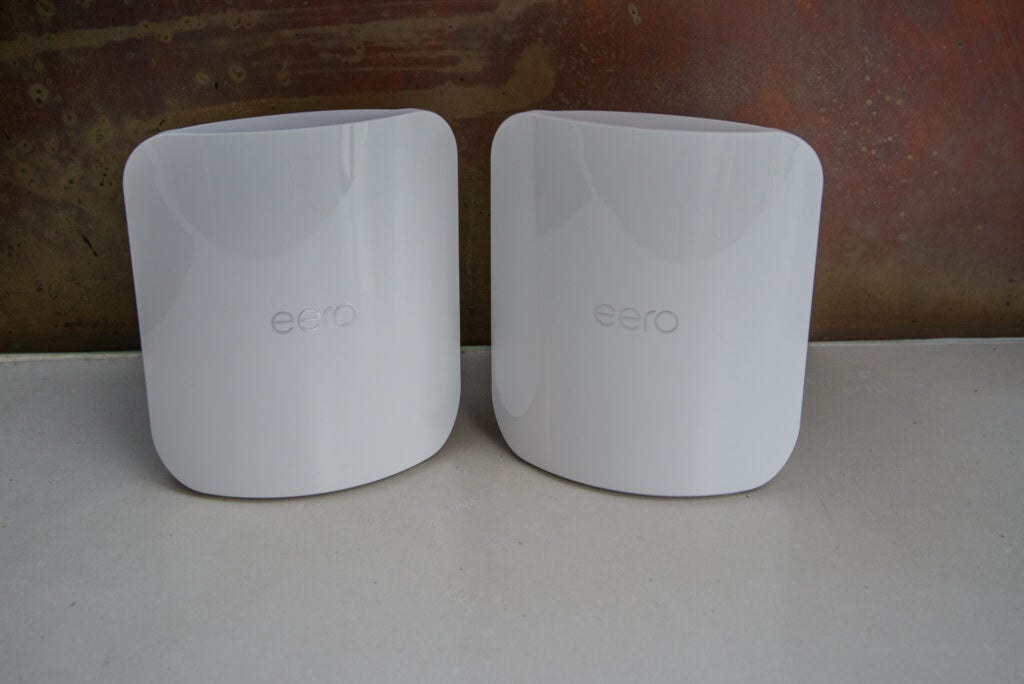Verdict
Incredibly fast, particularly with Wi-Fi 7 devices, the Eero Max 7 shows us what the next generation of Wi-Fi is capable of. Simple to set up and use, and with dual 10 Gigabit Ethernet ports (alongside two 2.5 Gigabit Ethernet ports), this router is a high-end beast, with a price to match.
Pros
- Extremely fast
- Easy to use
- Lots of high-speed Ethernet ports
Cons
- Expensive
- No web interface
-
Wi-Fi 7Runs Wi-Fi 7, delivering up to 4.3Gbit/s, this is a super-fast mesh system. -
Ethernet portsTwo 10 Gigabit Ethernet and two 2.5 Gigabit Ethernet ports per satellite.
Introduction
The first Wi-Fi 7 mesh system that I’ve reviewed, the Eero Max 7 is incredibly fast under the right circumstances and fully ready for the future of home networking.
Its high price and a relatively basic set of controls may be issues too far for some. I’ve tested Eero Max 7, so here are my thoughts.
Design and features
- Dual 10 Gigabit Ethernet ports
- Larger than previous Eero devices
- Backwards compatible but with caveats
Previous Eero devices that I’ve reviewed, such as the Eero Pro 6E, have been relatively small, and designed to tuck out of the way. The Eero Max 7 is different. Each satellite is far larger (222 x 184 x 90mm), which puts them closer in size to an Orbi system, such as the Orbi RBKE963.
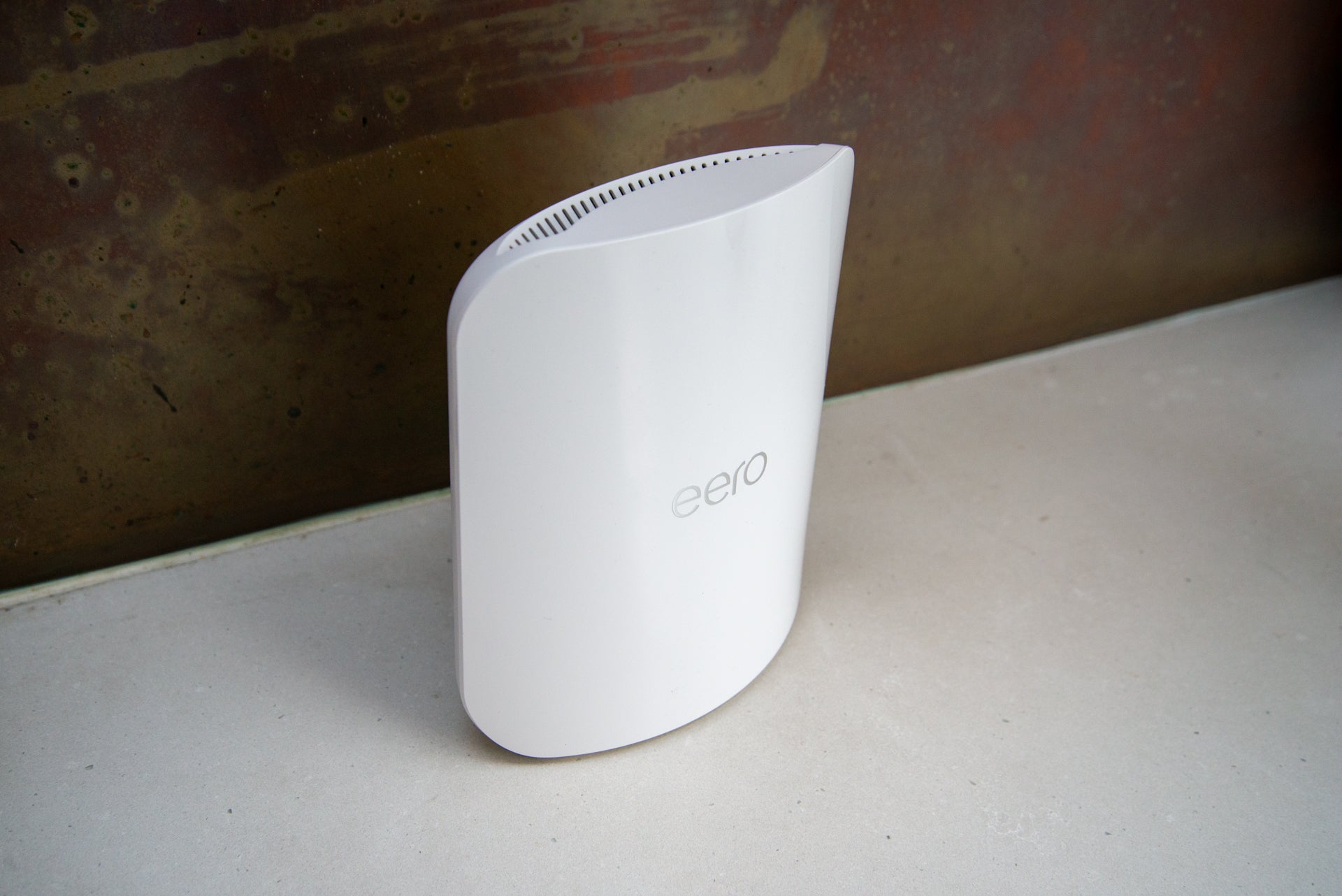
Not only is the Eero Max 7 larger, but it’s a lot more expensive than its predecessors: £599.99/$599.99 for one, £1149.99/$1149.99 for two and £1699.99/$1699.99 for three. That’s an absolutely staggering amount of money for a Wi-Fi system, particularly when the previous Pro 6E costs less for a three-pack than a single Eero Max 7.
Why so expensive, you might ask? It’s all down to the hardware inside, as the Eero Max 7 is packed with the latest technology. If I take the hardware in first, each satellite has two 10 Gigabit Ethernet ports and two 2.5 Gigabit Ethernet ports. That’s enough to handle the fastest internet speeds available today and for some considerable time into the future. And there are enough spare ports to provide the basis of a high-speed internal network.
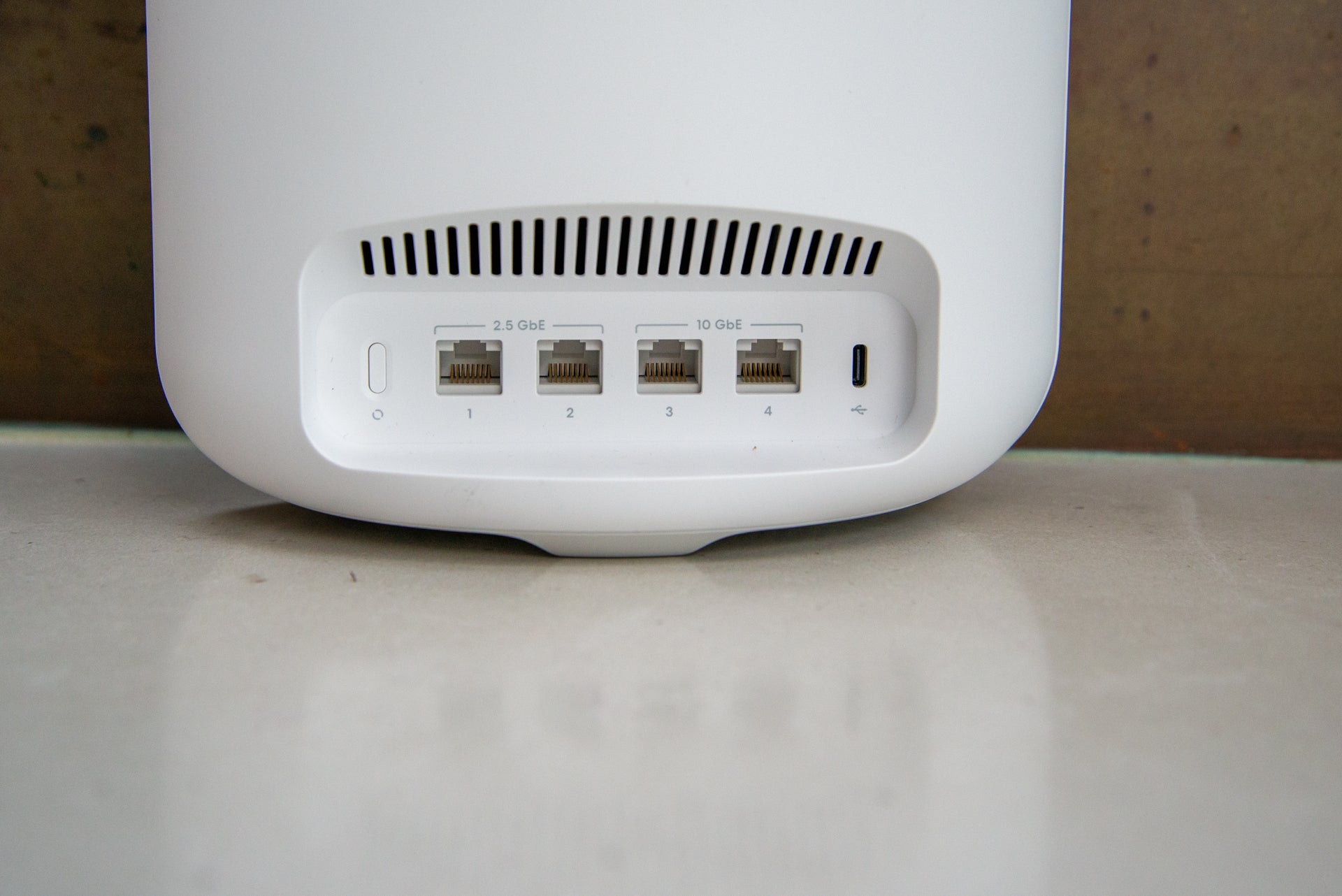
The other big difference is that there’s Wi-Fi 7 built in, which delivers speeds of up to 4.3Gbit/s wirelessly, which is some way ahead of the Eero Pro 6E, which had speeds of up to 1.6Gbit/s.
Wi-Fi 7 is a big improvement over Wi-Fi 6, offering throughputs of up to 46Gbit/s. A big change is that it supports Multi-Link Operation (MLO), where a client can use multiple links, running on different frequencies, at the same time to improve speeds. For example, a laptop could stream data using a combination of the 5GHz and 6GHz bands at the same time; with Wi-Fi 6E and below, devices could use one network at a time.
In addition, Wi-Fi 7 and the Eero Max 7 support 320MHz channel widths, double the 160MHz channels on the previous generation. With 2.4GHz (2×2), 5GHz (4×4) and 6GHz (4×4) networks available on the Eero Max 7, there’s a total of 10 streams available, each potentially running at higher speeds than on the old models.
There’s still no dedicated network for communication between satellites, so the wireless backhaul between devices is taken out of the available bandwidth. However, you can use a wired backhaul, using a chunky 10 Gigabit Ethernet port, if you really want to max out the connection between devices.
The setup of the Eero Max 7 is via the Eero app. If you’ve got an existing Eero system, you can technically integrate the Max 7 into your existing setup, and it is backwards compatible with all existing satellites. Should you mix and match? Probably not.
Mixing with an older generation limits what the Eero Max 7 is capable of, and disables some modes, such as 320MHz channel widths. You’d see some of the benefits but not all of them, so think of this system as a replacement for what you’ve got, rather than an add-on.
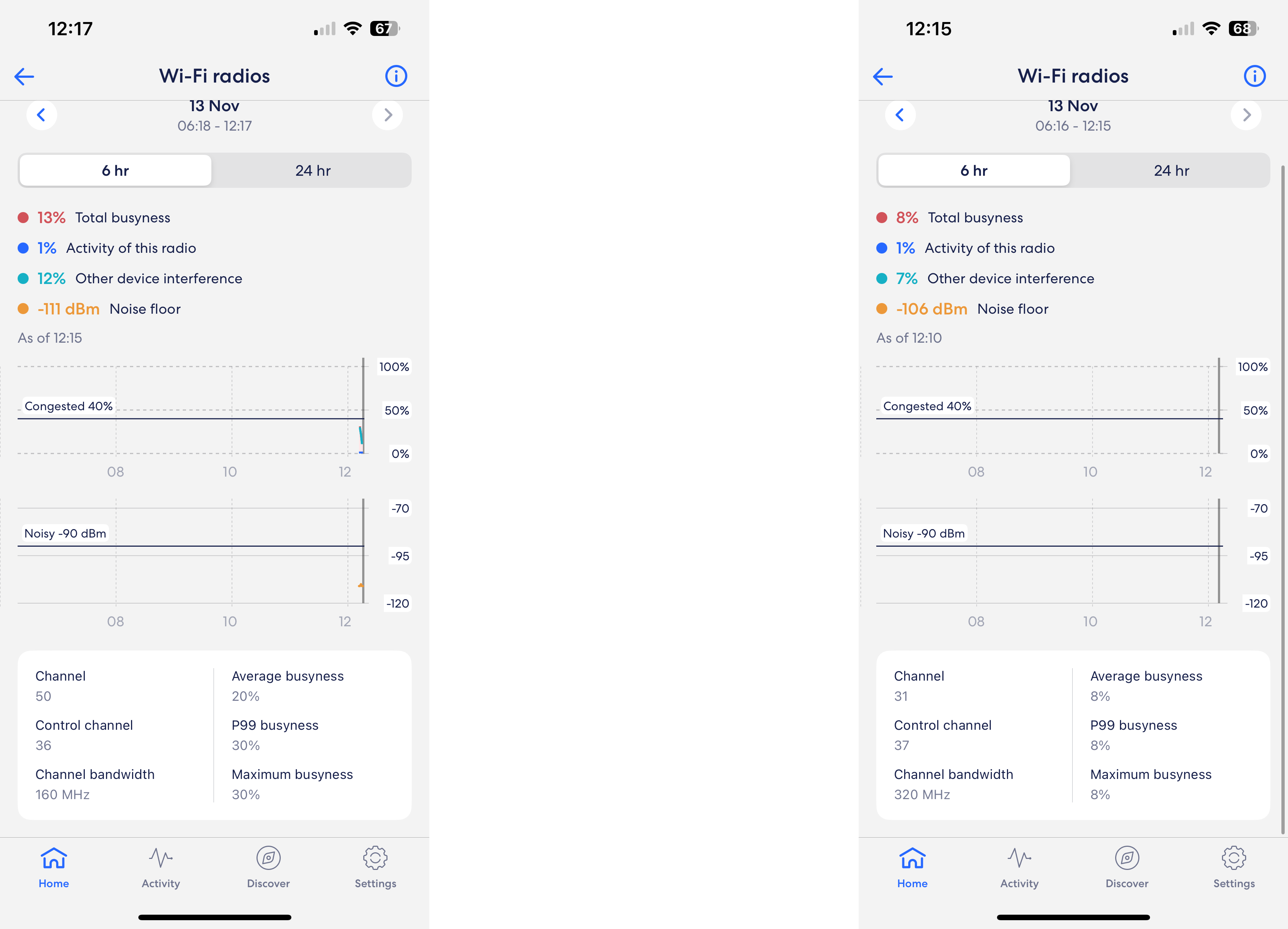
I find the Eero app a mix of the brilliant and the limited. At its best, the app makes controlling your network easy, both locally and remotely. I love the ability to create profiles and attach devices to them, setting schedules for when each profile can be online.
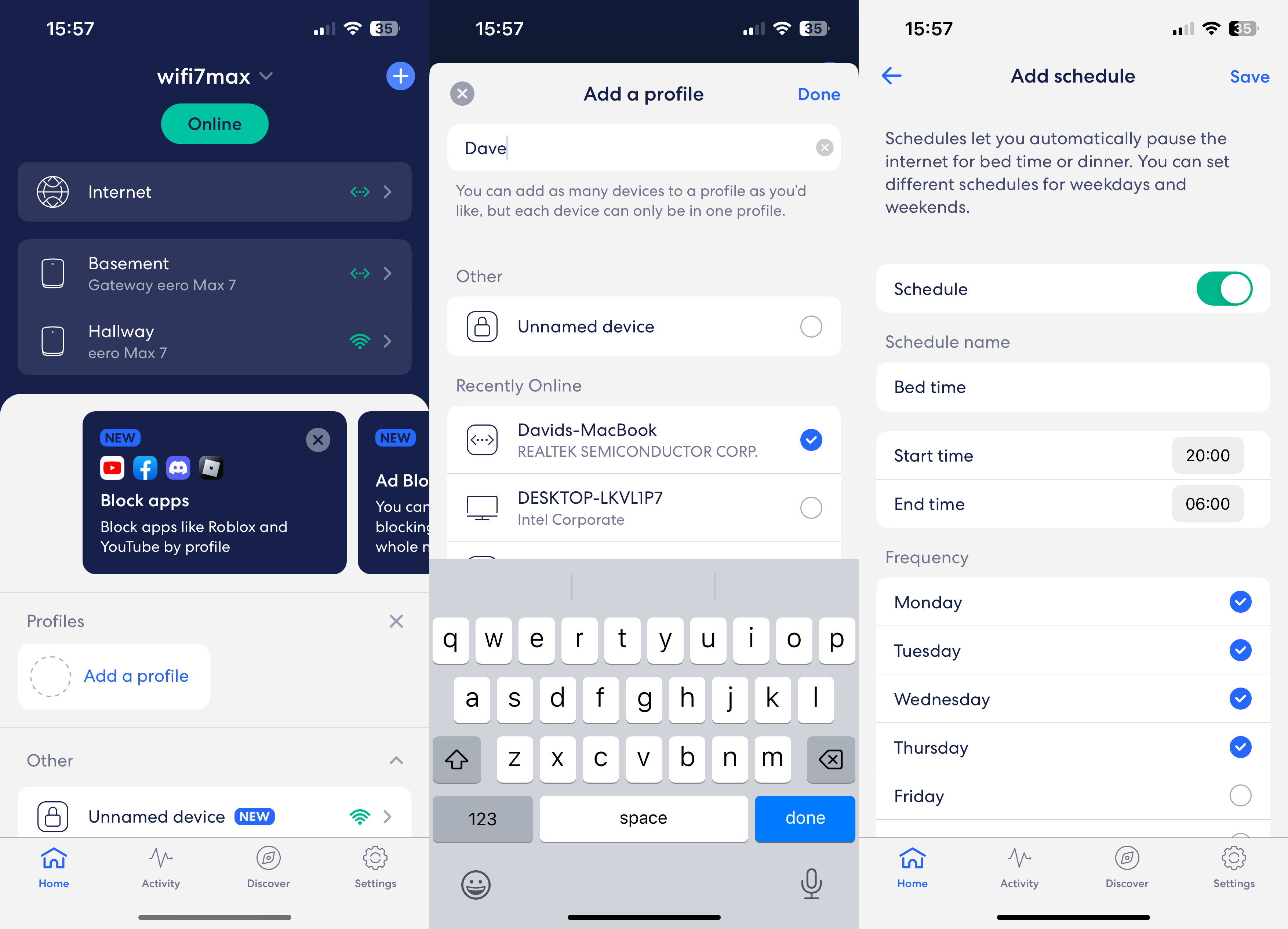
Upgrade to the Eero Secure+ subscription (£99.99/$99.99 a year), and you get detailed parental controls, ad-blocking, a three-device edition of Malwarebytes, and five-user versions of 1Password and Encrypt.me VPN. And, you get the Eero Internet Backup, where your Eero system can join a nearby Wi-Fi network should your internet connection go down. That could be a neighbour that’s willing to loan you their connection or a hotspot device.
Connect your Amazon account, and you can use the Smart Home Hub (Zigbee and Thread) to connect devices directly to Alexa. There’s also voice control, although the integration is slightly limited and I could pause a profile, but not turn the guest network on or off. I couldn’t pause individual devices, either; this option is only available in the US.
Otherwise, there’s very little that you can do, as there’s no web interface and a lack of advanced features, such as manual options to change the wireless channels in use.
Performance
- Scarily fast
- Good range
- Improves Wi-Fi 6 devices
I started by integrating the Eero Max 7 with my existing Eero Pro 6E system to see what would happen. It wasn’t that impressive. Limiting the Max 7 to 80Hz channel widths, performance was about the same as with a bog-standard Wi-Fi 6 system.
Setting the Eero Max 7 up as a brand-new device sorted things out. Here, it ran at 160MHz on the 5GHz band and 320MHz on the 6GHz band. I used a Xiaomi 13T Pro for testing, as this phone has built-in Wi-Fi 7 (supporting 2.4GHz, 5GHz and 6GHz). I then used a desktop PC as an OpenSpeedTest server, wired into a 10Gbit/s Ethernet port.
At close range, I saw an average of 1198.5Mbit/s, which is comfortably the fastest throughput I’ve seen from a wireless device. Switching to an iPhone 13 Pro (Wi-Fi 6), and throughputs were still an impressive 800.1Mbit/s.
I have a Wi-Fi 6E desktop computer, which I connected at 6GHz. Here, I managed a throughput of 1278.3Mbit/s, which is the fastest I’ve seen from a 6GHz connection.
Moving to the first floor, my Wi-Fi 7 device managed throughputs of 1316.95Mbit/s, while my Wi-Fi 6 device managed 525.90Mbit/s. On my second floor, performance was incredible: 1127.9Mbit/s from Wi-Fi 7 and a still impressive 439.15Mbit/s from Wi-Fi 6.
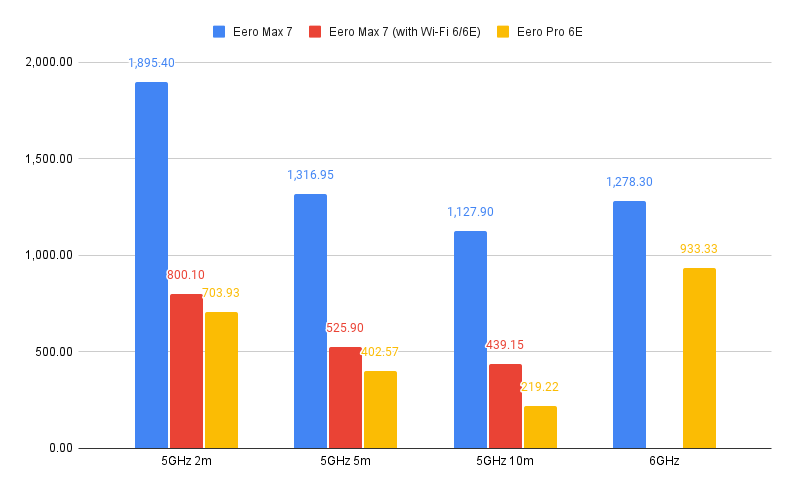
Overall, this is the fastest mesh system that I’ve ever tested, and it even improved on the Wi-Fi 6 performance of the Eero Pro 6E.
Latest deals
Should you buy it?
You want the best Wi-Fi speeds today
If you want a future-proof mesh system that delivers the fastest Wi-Fi speeds, the Eero Max 7 is hard to beat.
You have less elaborate needs
If you just want a fast, reliable mesh network for today, there are plenty of cheaper alternatives. Check out our Best Router guide for more options.
Final Thoughts
The Eero Max 7 isn’t necessarily a product for today, more one that bullet-proofs your network for tomorrow, boosting bandwidth and range, while ensuring it can handle the fastest internet speeds going.
Its high price is probably a little hard to stomach for most people, but if you’ve already got a Wi-Fi 7 device and want the latest technology, this mesh system certainly delivers on its promises. If you’ve lower requirements, check out our guide to the best routers.
How we test
Unlike other sites, we test every wireless router we review thoroughly over an extended period of time. We use industry standard tests to compare features properly. We’ll always tell you what we find. We never, ever, accept money to review a product.
Find out more about how we test in our ethics policy.
Used as our main wireless router for the review period
We throughput test all wireless devices using the same equipment in the same locations so that we have accurate comparisons
FAQs
Yes, you can mix and match, although doing so may hamper the Eero Max 7’s top speeds.
No, but you’ll only see the fastest speeds if you use Wi-Fi 7 devices.
Verdict
Incredibly fast, particularly with Wi-Fi 7 devices, the Eero Max 7 shows us what the next generation of Wi-Fi is capable of. Simple to set up and use, and with dual 10 Gigabit Ethernet ports (alongside two 2.5 Gigabit Ethernet ports), this router is a high-end beast, with a price to match.
Pros
- Extremely fast
- Easy to use
- Lots of high-speed Ethernet ports
Cons
- Expensive
- No web interface
-
Wi-Fi 7Runs Wi-Fi 7, delivering up to 4.3Gbit/s, this is a super-fast mesh system. -
Ethernet portsTwo 10 Gigabit Ethernet and two 2.5 Gigabit Ethernet ports per satellite.
Introduction
The first Wi-Fi 7 mesh system that I’ve reviewed, the Eero Max 7 is incredibly fast under the right circumstances and fully ready for the future of home networking.
Its high price and a relatively basic set of controls may be issues too far for some. I’ve tested Eero Max 7, so here are my thoughts.
Design and features
- Dual 10 Gigabit Ethernet ports
- Larger than previous Eero devices
- Backwards compatible but with caveats
Previous Eero devices that I’ve reviewed, such as the Eero Pro 6E, have been relatively small, and designed to tuck out of the way. The Eero Max 7 is different. Each satellite is far larger (222 x 184 x 90mm), which puts them closer in size to an Orbi system, such as the Orbi RBKE963.

Not only is the Eero Max 7 larger, but it’s a lot more expensive than its predecessors: £599.99/$599.99 for one, £1149.99/$1149.99 for two and £1699.99/$1699.99 for three. That’s an absolutely staggering amount of money for a Wi-Fi system, particularly when the previous Pro 6E costs less for a three-pack than a single Eero Max 7.
Why so expensive, you might ask? It’s all down to the hardware inside, as the Eero Max 7 is packed with the latest technology. If I take the hardware in first, each satellite has two 10 Gigabit Ethernet ports and two 2.5 Gigabit Ethernet ports. That’s enough to handle the fastest internet speeds available today and for some considerable time into the future. And there are enough spare ports to provide the basis of a high-speed internal network.

The other big difference is that there’s Wi-Fi 7 built in, which delivers speeds of up to 4.3Gbit/s wirelessly, which is some way ahead of the Eero Pro 6E, which had speeds of up to 1.6Gbit/s.
Wi-Fi 7 is a big improvement over Wi-Fi 6, offering throughputs of up to 46Gbit/s. A big change is that it supports Multi-Link Operation (MLO), where a client can use multiple links, running on different frequencies, at the same time to improve speeds. For example, a laptop could stream data using a combination of the 5GHz and 6GHz bands at the same time; with Wi-Fi 6E and below, devices could use one network at a time.
In addition, Wi-Fi 7 and the Eero Max 7 support 320MHz channel widths, double the 160MHz channels on the previous generation. With 2.4GHz (2×2), 5GHz (4×4) and 6GHz (4×4) networks available on the Eero Max 7, there’s a total of 10 streams available, each potentially running at higher speeds than on the old models.
There’s still no dedicated network for communication between satellites, so the wireless backhaul between devices is taken out of the available bandwidth. However, you can use a wired backhaul, using a chunky 10 Gigabit Ethernet port, if you really want to max out the connection between devices.
The setup of the Eero Max 7 is via the Eero app. If you’ve got an existing Eero system, you can technically integrate the Max 7 into your existing setup, and it is backwards compatible with all existing satellites. Should you mix and match? Probably not.
Mixing with an older generation limits what the Eero Max 7 is capable of, and disables some modes, such as 320MHz channel widths. You’d see some of the benefits but not all of them, so think of this system as a replacement for what you’ve got, rather than an add-on.

I find the Eero app a mix of the brilliant and the limited. At its best, the app makes controlling your network easy, both locally and remotely. I love the ability to create profiles and attach devices to them, setting schedules for when each profile can be online.

Upgrade to the Eero Secure+ subscription (£99.99/$99.99 a year), and you get detailed parental controls, ad-blocking, a three-device edition of Malwarebytes, and five-user versions of 1Password and Encrypt.me VPN. And, you get the Eero Internet Backup, where your Eero system can join a nearby Wi-Fi network should your internet connection go down. That could be a neighbour that’s willing to loan you their connection or a hotspot device.
Connect your Amazon account, and you can use the Smart Home Hub (Zigbee and Thread) to connect devices directly to Alexa. There’s also voice control, although the integration is slightly limited and I could pause a profile, but not turn the guest network on or off. I couldn’t pause individual devices, either; this option is only available in the US.
Otherwise, there’s very little that you can do, as there’s no web interface and a lack of advanced features, such as manual options to change the wireless channels in use.
Performance
- Scarily fast
- Good range
- Improves Wi-Fi 6 devices
I started by integrating the Eero Max 7 with my existing Eero Pro 6E system to see what would happen. It wasn’t that impressive. Limiting the Max 7 to 80Hz channel widths, performance was about the same as with a bog-standard Wi-Fi 6 system.
Setting the Eero Max 7 up as a brand-new device sorted things out. Here, it ran at 160MHz on the 5GHz band and 320MHz on the 6GHz band. I used a Xiaomi 13T Pro for testing, as this phone has built-in Wi-Fi 7 (supporting 2.4GHz, 5GHz and 6GHz). I then used a desktop PC as an OpenSpeedTest server, wired into a 10Gbit/s Ethernet port.
At close range, I saw an average of 1198.5Mbit/s, which is comfortably the fastest throughput I’ve seen from a wireless device. Switching to an iPhone 13 Pro (Wi-Fi 6), and throughputs were still an impressive 800.1Mbit/s.
I have a Wi-Fi 6E desktop computer, which I connected at 6GHz. Here, I managed a throughput of 1278.3Mbit/s, which is the fastest I’ve seen from a 6GHz connection.
Moving to the first floor, my Wi-Fi 7 device managed throughputs of 1316.95Mbit/s, while my Wi-Fi 6 device managed 525.90Mbit/s. On my second floor, performance was incredible: 1127.9Mbit/s from Wi-Fi 7 and a still impressive 439.15Mbit/s from Wi-Fi 6.

Overall, this is the fastest mesh system that I’ve ever tested, and it even improved on the Wi-Fi 6 performance of the Eero Pro 6E.
Latest deals
Should you buy it?
You want the best Wi-Fi speeds today
If you want a future-proof mesh system that delivers the fastest Wi-Fi speeds, the Eero Max 7 is hard to beat.
You have less elaborate needs
If you just want a fast, reliable mesh network for today, there are plenty of cheaper alternatives. Check out our Best Router guide for more options.
Final Thoughts
The Eero Max 7 isn’t necessarily a product for today, more one that bullet-proofs your network for tomorrow, boosting bandwidth and range, while ensuring it can handle the fastest internet speeds going.
Its high price is probably a little hard to stomach for most people, but if you’ve already got a Wi-Fi 7 device and want the latest technology, this mesh system certainly delivers on its promises. If you’ve lower requirements, check out our guide to the best routers.
How we test
Unlike other sites, we test every wireless router we review thoroughly over an extended period of time. We use industry standard tests to compare features properly. We’ll always tell you what we find. We never, ever, accept money to review a product.
Find out more about how we test in our ethics policy.
Used as our main wireless router for the review period
We throughput test all wireless devices using the same equipment in the same locations so that we have accurate comparisons
FAQs
Yes, you can mix and match, although doing so may hamper the Eero Max 7’s top speeds.
No, but you’ll only see the fastest speeds if you use Wi-Fi 7 devices.


















